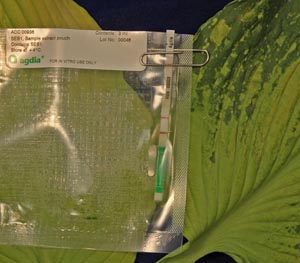Hosta Virus X Positive | |
|---|---|
| July 25, 2008 | |
|
A recent hosta sample at the University of Illinois Plant Clinic has tested positive for hosta virus X (HVX). This particular hosta cultivar is normally a greenish yellow color. The infected leaves were mottled darker green and light green. Some might argue that the mottled leaves were more attractive than the solid-colored leaves. The problem is that the virus-infected plants become weakened and eventually decline. Hosta virus X can cause a variety of symptoms on hostas, depending on the cultivar and the age when infected. Be familiar with the cultivars you purchase and know what is normal for that cultivar. You might see many different symptoms in HVX-infected plants, including mottling, odd blotches of color, puckering of leaves, twisting, and even ring spots. Some cultivars can even be unsymptomatic carriers. An immunostrip test was used to confirm our recent sample. An immunostrip is a very convenient way to use ELISA (enzyme-linked immunosorbant assay). The ELISA is performed on a thin membrane mounted in a dipstick, rather than in wells. The image shows a positive reaction with HVXon an immunostrip with healthy hosta tissue on the left and HVX-infeccted tissue on the right.  HVX is spread mechanically, so you might spread it with your tools, on your hands, or when you share plants. Any plant that is infected with a virus is infected for life. Some plants can coexist with the virus, and some plants are weakened by the virus. To avoid spread to other hostas, remove HVX-infected plants. The virus cannot survive without living plants, but it can remain in the roots until they decompose. For this reason, remove as much of the roots as possible, and do not replant into that area until the roots are completely decomposed. There are no chemicals that kill the virus without also killing the plant. | |
| Author: | Nancy Pataky |
